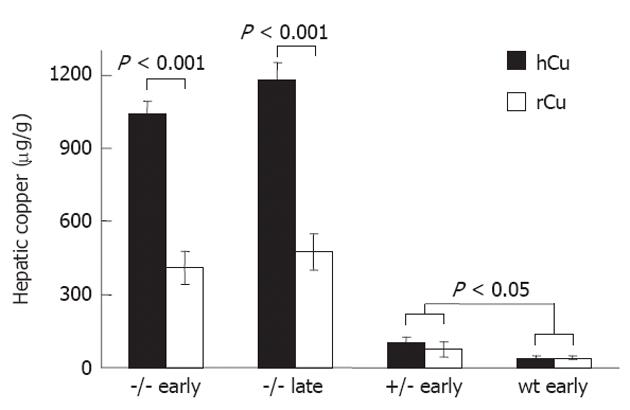Copyright
©2012 Baishideng Publishing Group Co.
World J Gastroenterol. Oct 21, 2012; 18(39): 5542-5550
Published online Oct 21, 2012. doi: 10.3748/wjg.v18.i39.5542
Published online Oct 21, 2012. doi: 10.3748/wjg.v18.i39.5542
Figure 1 Schematic representation of study design.
For the early copper regimen, Long-Evans cinnamon (LEC) rat pups received a high copper (hCu) diet up to month 3. For the late copper regimen, LEC pups were first housed on a reduced copper (rCu) diet until adult (month 5). Thereafter, rats received hCu for 3 mo up to the end of observation time (month 8). LEC rats received rCu diet throughout the observation period (early/late). ATP7B heterozygotes as well as Long-Evans agouti rats were also studied using an early hCu regimen. Arrow indicates start of hCu regimen.
Figure 2 High copper regimen induces fulminant hepatitis.
A: Bilirubin, aspartate transaminase (AST) and alanine aminotransferase (ALT) were determined in Long-Evans cinnamon (LEC) rats (-/-), heterozygotes (+/-) or Long-Evans agouti (LEA) rats (wt). Animals received a high copper (hCu) or reduced copper (rCu) diet as an early or late regimen. Median ± SE of maximal values obtained from animals are shown; B: Time course of serum markers in LEC rats that received early (top) or late (bottom) hCu. X-axis represents day after start of hCu. Animals of other groups showed normal levels. Of note, the onset of increased values following late hCu was at day 189 ± 42 after birth. Each line represents one animal. Logrank test using threshold (mean ± SE of LEA rats ×2) was used; C: Kaplan-Meier survival curve of LEC rats receiving an early and late hCu regimen are shown. Survival is represented as day after start of hCu. Of note, age of animals at death in late group was 190 ± 9 d.
Figure 3 Liver of Long-Evans cinnamon rats is significantly affected by high copper regimen.
Hematoxylin and eosin staining of liver. Livers were obtained from Long-Evans cinnamon rats that received high copper at an early or late time point (A, B) or after a reduced copper diet (C: late regimen). As a control, liver of Long-Evans agouti rat is depicted (D). Note highly irregular architecture of liver parenchyma, polyploidy, enlarged nuclei and inflammation (A, B) as compared to C and D. Liver histology of other groups was normal. One representative staining (40× magnification) of female rats is shown.
Figure 4 Increased liver copper is found in Long-Evans cinnamon rats irrespective of copper diet.
Copper was determined in the liver of Long-Evans cinnamon rats (-/-; n = 9), heterozygotes (+/-; n = 5) and Long-Evans agouti rats (wt; n = 3) after receiving high copper (hCu) or reduced copper (rCu) diet according to an early or late regimen, respectively. Copper concentration is given as mean ± SE of liver dry weight.
Figure 5 Ceruloplasmin oxidase is independent of high copper treatment.
Ceruloplasmin (CP) oxidase was determined in Long-Evans cinnamon rats (-/-) that received high copper (hCu) or reduced copper (rCu). Sera (n = 6) were obtained from animals after an early or late hCu regimen. As control, values obtained from Long-Evans agouti rats (wt) (n = 3) are shown. Data are expressed as mean ± SE.
Figure 6 Liver gene expression of Long-Evans cinnamon rat is significantly altered after high copper regimen.
Relative expression of individual mRNA in Long-Evans cinnamon (LEC) rats (n = 7) that were subjected to early high copper (hCu) regimen (left boxes) and in age-matched LEC rats (n = 5) receiving reduced copper (rCu) (right boxes). Animals were analyzed at fulminant hepatitis. Fold-change was calculated within groups by the Δct method using the HPRT gene for normalization. Data are shown as a box plot representation as calculated from three independent experiments. Numbers refer to difference of fold-change with regard to the median of each group.
- Citation: Siaj R, Sauer V, Stöppeler S, Spiegel HU, Köhler G, Zibert A, Schmidt HH. Dietary copper triggers onset of fulminant hepatitis in the Long-Evans cinnamon rat model. World J Gastroenterol 2012; 18(39): 5542-5550
- URL: https://www.wjgnet.com/1007-9327/full/v18/i39/5542.htm
- DOI: https://dx.doi.org/10.3748/wjg.v18.i39.5542


















